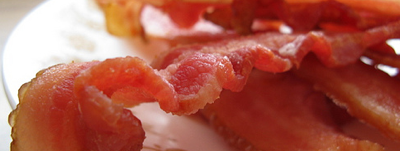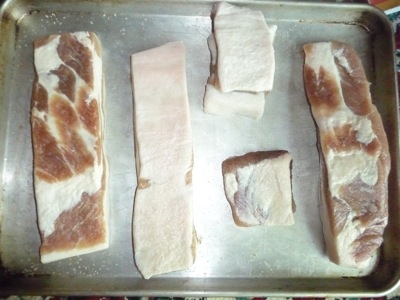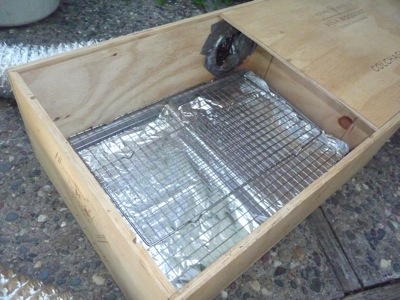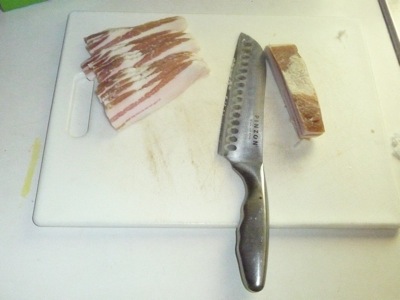 When it comes to making and preparing food, you can’t get much more local than homemade. When your food is prepared, cooked, and served all in the same factory – a home kitchen – there is a sense of ownership over the food. It’s not just the sense of accomplishment, but also because it is so much easier to know your ingredients. There are tons of prepared, cured, and processed foods on the shelves of grocery stores that used to be made at home - they’d be much better tasting (and better for us) if they still were. It may seem like a lot of effort to make your own ketchup, jam, cake, or bacon; but it doesn’t need to be. Bacon is one of those foods that is processed to death in grocery stores and is so delicious homemade. I recently cured and smoked my own bacon and had a great time doing so. Read on and see how little effort it actually takes to make some tasty bacon. Bacon begins with pork belly. This cut is fatty and flavorful. Since it really is the belly (unlike the confusingly named pork shoulder and butt), you might find it with the skin on. There are a lot of good local producers to get your belly from; check the SGT Directory to find one. You’ll probably find pork belly in 1-3 lb. portions, and that’s a good size to cure. To get the belly ready to cure, make sure the pork is really fresh and any skin is off. REMEMBER: Through this whole process, the meat is raw. Curing and smoking will prevent spoilage, but you must be careful to avoid contaminating your kitchen with raw pork. First comes the curing. Curing meat entails drawing the liquids out of it with salt so bacteria don’t have as much of a chance to grow. To counteract the harshness of a lot of salt in the meat, you can add a variety of sweet flavors – any type of sugar, maple syrup, or preserves (I want to try blackberry preserves, but haven’t yet). The proportion of salt to sweet is somewhat arbitrary, but I suggest 1:1. After a few batches, you will be able to fine-tune the cure to your liking.
When it comes to making and preparing food, you can’t get much more local than homemade. When your food is prepared, cooked, and served all in the same factory – a home kitchen – there is a sense of ownership over the food. It’s not just the sense of accomplishment, but also because it is so much easier to know your ingredients. There are tons of prepared, cured, and processed foods on the shelves of grocery stores that used to be made at home - they’d be much better tasting (and better for us) if they still were. It may seem like a lot of effort to make your own ketchup, jam, cake, or bacon; but it doesn’t need to be. Bacon is one of those foods that is processed to death in grocery stores and is so delicious homemade. I recently cured and smoked my own bacon and had a great time doing so. Read on and see how little effort it actually takes to make some tasty bacon. Bacon begins with pork belly. This cut is fatty and flavorful. Since it really is the belly (unlike the confusingly named pork shoulder and butt), you might find it with the skin on. There are a lot of good local producers to get your belly from; check the SGT Directory to find one. You’ll probably find pork belly in 1-3 lb. portions, and that’s a good size to cure. To get the belly ready to cure, make sure the pork is really fresh and any skin is off. REMEMBER: Through this whole process, the meat is raw. Curing and smoking will prevent spoilage, but you must be careful to avoid contaminating your kitchen with raw pork. First comes the curing. Curing meat entails drawing the liquids out of it with salt so bacteria don’t have as much of a chance to grow. To counteract the harshness of a lot of salt in the meat, you can add a variety of sweet flavors – any type of sugar, maple syrup, or preserves (I want to try blackberry preserves, but haven’t yet). The proportion of salt to sweet is somewhat arbitrary, but I suggest 1:1. After a few batches, you will be able to fine-tune the cure to your liking. 

I hope you enjoy your bacon! Whether you bake it or fry it, homemade bacon is meaty and delicious. If yours, like some of mine, is too salty, you can soak the slices in water for a little bit before cooking. Just make sure to dry the surface off before cooking. Your final product is great as part of a hearty breakfast, good BLT, or wrap for a tenderloin. Now a few notes on curing. Most store-bought bacon has nitrites (salt peter) in it. It helps preserve the meat but is also in fireworks, so I avoid eating it. You can add it to your cure if you prefer, but it’s not necessary. Another way to go about curing is to soak the pork belly in a brine for several days. Add ½ cup each of salt and your sweet addition per gallon of water. Make sure there is enough liquid to fully cover the meat and put it in a sealed bag in the fridge.
This post was written by Alex Christensen. You can read his bio here, follow him on Twitter, or join the soon-to-be-formed Alex Christensen fan club.






